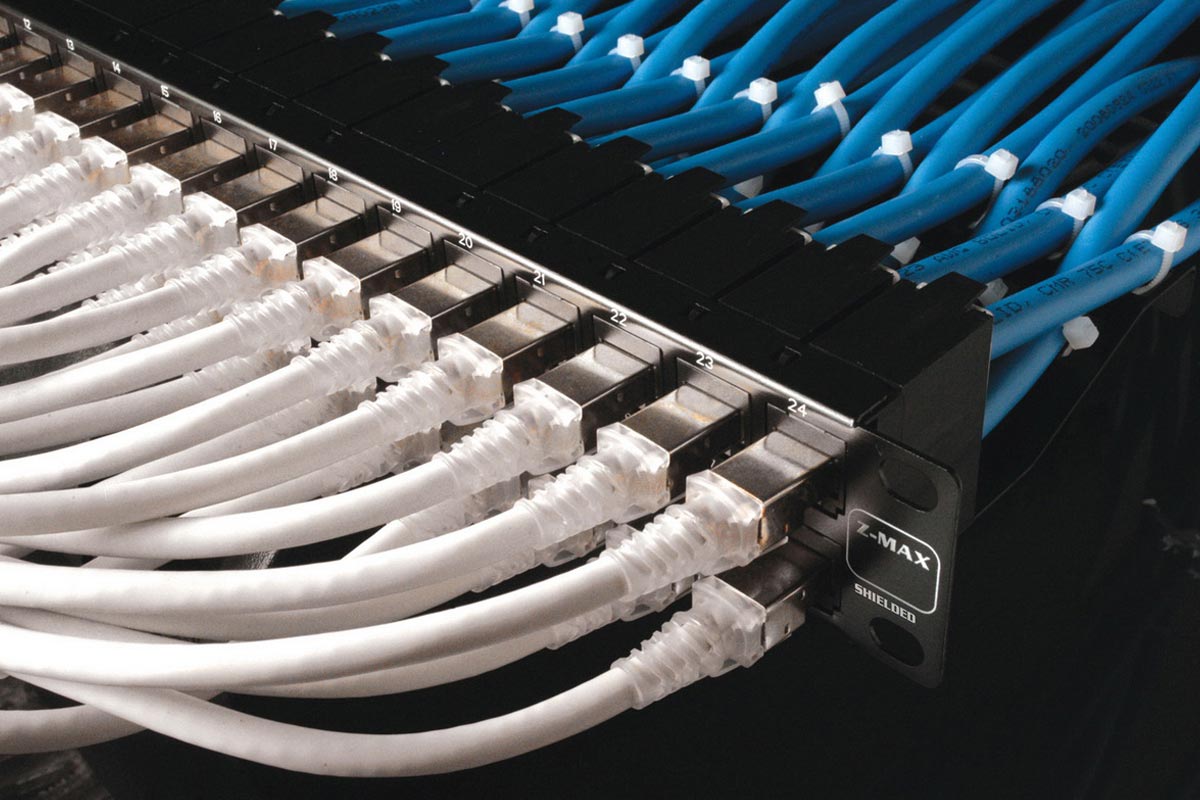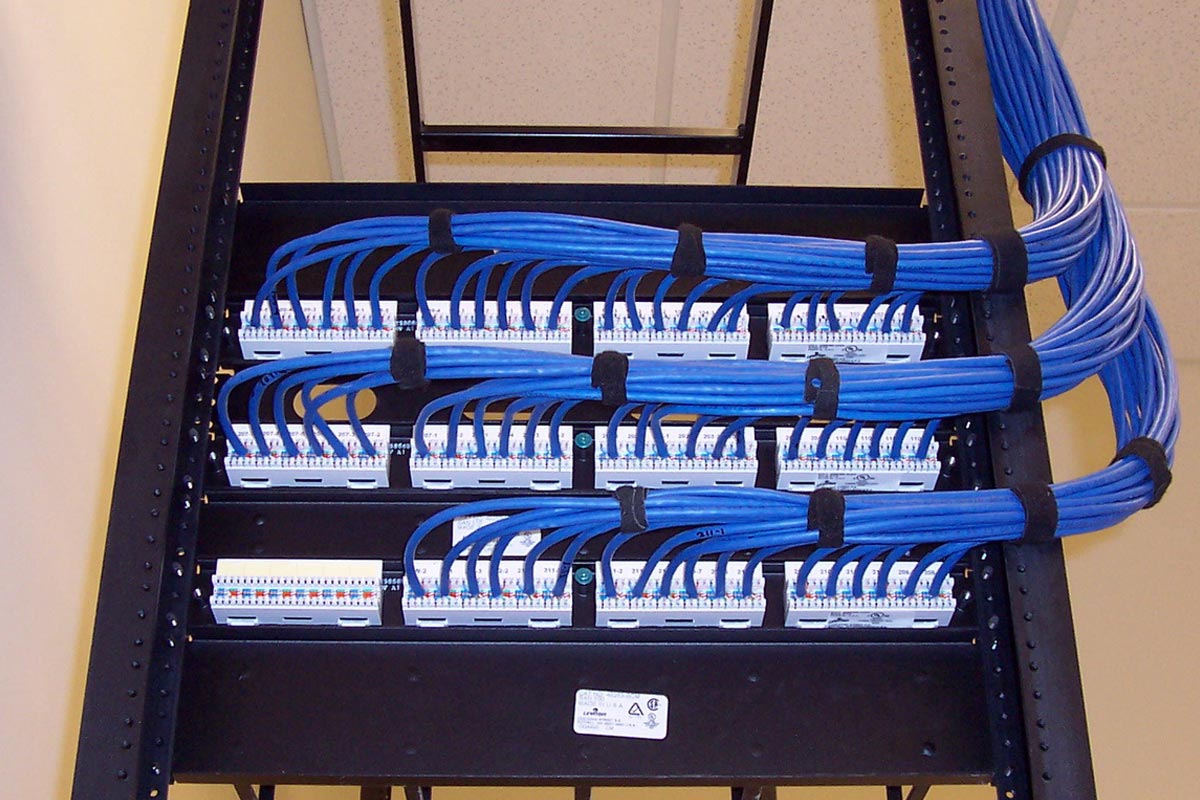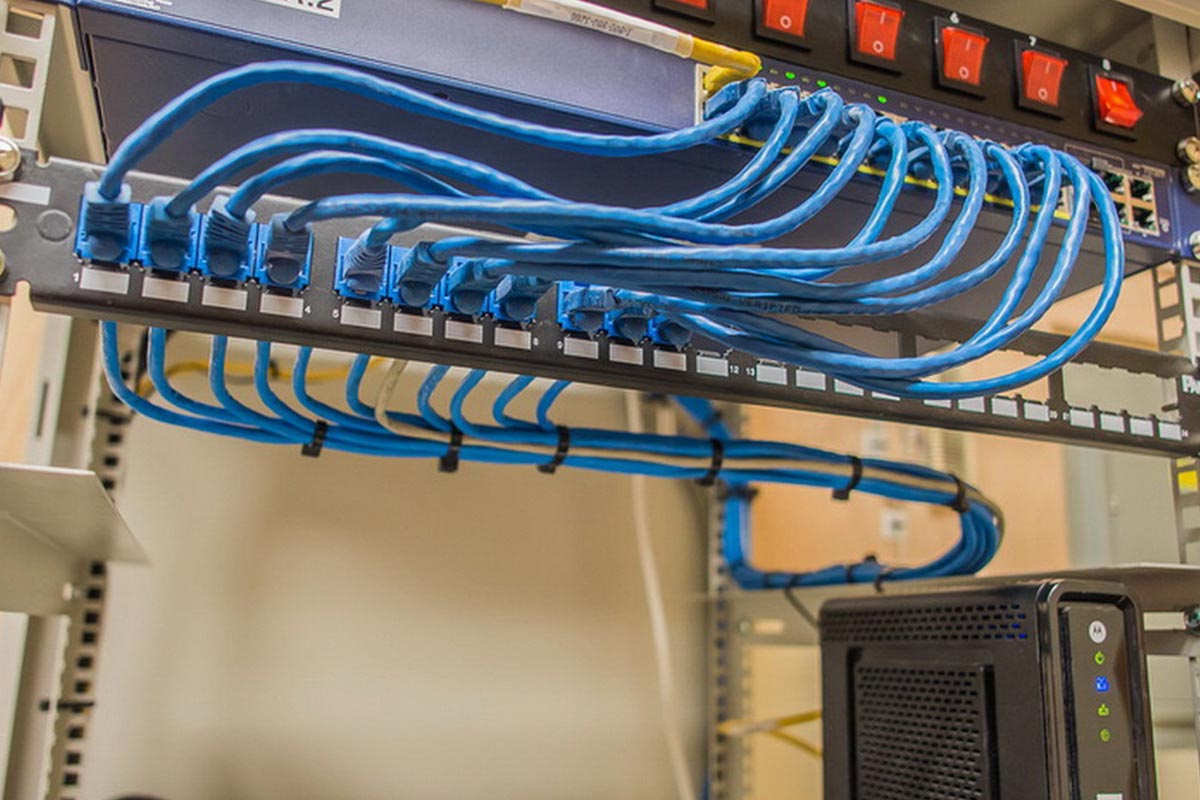Cabling Services Charlotte, NC
Cabling Services Charlotte, NC
Axis DataCom works to minimize expensive voice and data network problems by following the highest standards for installation and testing. We provide our customers with extensible networks flexible enough to install any combination of computers, printers, phones, video surveillance equipment, modems and any number of other analog and digital devices at any location. Axis DataCom can handle cabling projects of any size, including adding one to several cable drops and your Move/Add/Change (MAC) work. All structured data cabling installed by Axis DataCom is future-proofed. Our staff are highly trained and BICSI RCDD certified and we warranty our products and service so you can be sure your investment will be free of worry for years to come.
A Complete Range of Services
Our cabling professionals offer a comprehensive range of services, from the design of your structured network data cabling system to installation, testing, and documentation. We provide the services you need for successful installation. We can provide cabling for voice, data, and video systems in offices and corporate campuses. All our data center projects are deployed to exacting standards.
Structured Cabling
Looking to move an existing office or cubicle? Are you expanding your current office? Are you rearranging your floor plan or restructuring your personnel within your current space? Axis DataCom can develop and provide a foundation for all your communications/VoIP, or network/data adds, moves and changes. We install Category 5E, Category 6/6A and OM3/OM4 fiber optic networks for tenant improvement, design build, high rise/multi-story, and campus environments. We also install Coaxial RG-6 and RG-11 for broadband applications. Call today to speak with one of our structured cabling engineers (844) 609-3808.
CATEGORY 5/5E CABLING
Category 5/5E systems are designed to support IEEE 802.3, 100 Base-T and other legacy LAN and voice applications. Our systems not only exceed TIA 568B.2 and ISO 11801 for Category 5e / Class D cabling systems, but are also capable of providing stable and continuous performance beyond 100 MHz. Currently, Category 5/5E is the lowest cost solution available today.
CATEGORY 6/6A CABLING
Category 6/6A systems are relatively new to the industry. These systems are typically more expensive than traditional Category 5E cabling and are designed for companies and businesses that require the expanded bandwidth for advanced applications and large packet and file transfer speeds.
Category 6/6A systems are designed to support IEEE 802.3 1000-Base-T, TIA-854-A 1000-Base-MA, ATM Forum CBIG plus other legacy LAN Voice/Telephony. Category 6A also provides excellent protection from EMI and alien crosstalk issues inherent in manufacturing and industrial environments.
Our systems meet or exceed Category 6/Class E Channel Specifications to 250 MHz and are capable of delivering network speeds in excess of 1.2 Gbps to the workstation at 100 meters.
CATEGORY 6E/10X SYSTEMS
These copper systems are the most expensive solution on the market today! Category 6E/10X systems are designed for customers with long range plans or are investing in application assurance beyond today's requirements.Category 6E/10X systems are designed to support IEEE 802.3 10G-Base-T, 1000-Base-T TIA-854-A 1000- Base-MA, ATM Forum CB1G, and other LAN, Voice/Telephony and Video-BAS applications. Our systems meet or exceed draft Category 6A/Class E/A channel specifications to 500 MHz as well as the latest TIA/EIA and ISO/IEC augmented Category 6/Class E/A requirements. These systems are all backwards compatible and will support all legacy systems currently on the market today.
- Fiber Optic Cabling & Wiring Services Charlotte, NC
- New Fiber Optic Cabling Installations Charlotte, NC
- Troubleshooting and repair Fiber Optic Cabling Charlotte, NC
- Fiber Optic Cabling Fusion splicing Charlotte, NC
- Multi-mode 50/125, 62.5/125 Micron Fiber Optic Charlotte, NC
- Single-mode 8.3/125 Micron Fiber Optic Cabling Charlotte, NC
- Innerduct Fiber Optic Cabling Charlotte, NC
- Plenum and PVC Fiber Optic Cabling Charlotte, NC
- Outside plant Fiber Optic Cabling (OSP) installation and repair Charlotte, NC
- High Count Fiber Optic Cabling installation Charlotte, NC
- Every Fiber Optic Cabling installed covered by a 15 year warranty
- Every Fiber Optic Cabling tested and certified Charlotte, NC
Fiber optic cable and fiber optic data transmission technology revolutionized data transfer in the late 20th century. By encoding data as pulses of light, rather than pulses of electricity, data densities on fiber optic cables far exceeded their copper counterparts. The data is sent, literally, at light-speed over fiber optic cables.
Single-Mode Fiber
Single-mode fibers have a narrower core and allow for one data stream, or mode, to be transmitted over very long distances. Single mode fiber carries far more bandwidth, but in a narrower spectral width, than multi-mode fiber.
Multi-Mode Fiber
Multi-mode fiber strands use a much thicker core than single mode. Multi-mode fiber can carry data encoded using multiple light sources, thus allowing for multiple data streams to travel over a single optical fiber. The downside of multi-mode is transmission distance and available data bandwidth. Multi-mode transmission is good over shorter distances and can not support the high bandwidth of single-mode fibers.
Plastic Fiber
Plastic optical fiber (POF) is usually not used for data transmission. Plastic fiber optic cables do not have the optical purity required for reliable data transmission. POF is usually used for decorative and aesthetic transmission of light. Examples of this are toys where light is transmitted through the fibers creating beautiful, colorful clumps of optical fibers. An added advantage of POF over glass fiber in entertainment or aesthetic situations is durability and cost. POF is much cheaper to manufacture than glass fiber and is not as fragile.
The Future of Fiber Optic Cable
Current research into future fiber optic cable technology will allow tunable cables similar to a radio. Data streams on a single mode fiber will be able to be contained within a particular light spectrum and will be tunable similar to a present-day radio.
Multi-mode Vs. Single-Mode Fiber
An optical fiber refers to a flexible, thin fiber through which light can be transmitted via internal reflections. Optical fibers can take the form of single-mode or multi-mode fibers.
Core Differences
Multi-mode fiber and single-mode fibers have significant core differences. Multi-mode fibers contain light-carrying cores that are 62.5 microns or more in diameter. Single-mode fiber contains a light-carrying core that has a diameter between 8 and 10 microns. A micron is one-millionth of a meter.
Bandwidth Differences
A multi-mode fiber provide bandwidth transmissions of a few hundred megahertz (MHz) per kilometer (km) of length. Multi-mode fibers permit transmission distances of up to approximately 10 miles and can be used with receivers and optic transmitters that are relatively inexpensive. Single-mode fibers transmit over distances greater than 10 miles, but must be used with solid-state laser diodes or other single-mode transmitters. A diode refers to a device composed of two terminals that conduct currents in one direction. Single-mode transmitters can be up to four times as expensive as multi-mode fiber equipment.
What Is Dual Mode Fiber Optic Cable?
A fiber optic cable is a thin glass strand used for transmitting light. Fiber optic cables are used primarily by telephone companies and electric companies. They are typically either single mode or dual mode, also called multi-mode.
Types
Single mode fiber optic cables are used for high speed and long distances; dual mode fiber optic cables are primarily used for short distances.Details
Dual mode fiber optic cables have a slightly bigger diameter than single mode. Dual mode generally uses two fibers instead of one and offers a high bandwidth. Dual mode cables are not used for long distances, over 3,000 feet, because the multiple light paths lead to distortion to the receiving party.
Specifications
Dual mode fiber optic cables are made of glass and have diameters between 50 microns to 100 microns. Light is transferred through these cables using numerous paths. A single mode fiber optic contains a diameter between 8.3 microns to 10 microns and light is transferred via one path only.
Advantages & Disadvantages of Fiber Optic Cables
Fiber optic cabling for high speed Internet, telephone and cable connections is a technology with many advantages and limited disadvantages. Fiber optic cables transfer data via light waves. They are made from glass or plastic fibers in the core of the cable, surrounded by a "cladding" layer (designed to reflect light back towards the core), and the "buffer coating", which protects the fibers from moisture and other damage.
Advantage
Fiber optic data transmission is incredibly fast.
Advantage
Fiber optic cables are not susceptible to RF (radio frequency) interference, which can be a major problem for users of typical coaxial cabling.
Advantage
Fiber optic cables can transmit data over exceptionally long distances without much data loss.
Disadvantage
Often times, fiber optic cabling can cost more than double what a typical broadband connection costs, it is often hard for the average user to justify the costs.
Disadvantage
Fiber optic connections are not available in many areas.
Fun Fact
Many gaming systems and home theater components now also transfer information back and forth via fiber-optic cables.
Bandwidth Capacity of Fiber Optic Cable
Fiber optic cable transmits information using light signals. Fiber optic networks operate under the standards 10 Base-F, 100 Base-F, FDDI, FDDI duplex, 1000 Base-F and 10 Gbase, which include bandwidth capacity in their definitions.
Single and Multi-mode Fiber
Single mode fiber optic cable is the earliest form of fiber optic cable. This type of cable sends a single beam of light down the cable. Multi-mode fiber optic cable is an improved version of fiber optic communication. Because multi-mode fiber sends several light beams that combine into one signal, performance may be slightly higher, as the multi-mode installation includes several lasers which may combine to produce a maximum transmission rate greater than the specification standard rate to improve reliability. For example, a 10 gigabyte multi-mode network may include four lasers sending at 3 gigabytes.
10 Base-F
Older installations operate with lower bandwidth, especially if the signal is sent over long distances without amplification. The 10 Base-F standards from 1993 are the earliest standard for fiber optic transmission over Ethernet networks, according to the University of California, Berkeley. 10 Base networks send information at 10 megabytes per second.
Fiber Distributed Data Interface
FDDI, or fiber distributed data interface, is an alternative to an Ethernet network. FDDI is specifically designed for fiber optic communication, unlike Ethernet specifications designed for use with copper wires. FDDI uses both single mode cable to connect separate structures and multi-mode cable inside a structure, according to the University of California, Berkeley. FDDI networks are arranged in a ring of computers that pass an electronic token around the ring to communicate, this structure is known as a token ring network. The FDDI standard is a 100 megabyte per second network. FDDI-2 sends video images as well as data with a 100 megabyte per second standard. FDDI duplex mode sends data at double speed, allowing 200 megabyte per second communication.
Fast Ethernet
Some networks send data at 100 megabyte per second. The standards that govern these fiber networks are included in the 100 Base-F family. Any of the 100 Base, or 100 megabyte per second, standards including the fiber optic standard are referred to as Fast Ethernet.
1000 Base-F
Fiber Ethernet networks are installed under the 1000 Base-F standard. This standard allows transmission of data at one thousand megabytes per second. As with the other standard families there are related Ethernet specifications, such as 1000 Base-FX, that also operate at the same speed.
10 GBase
The 10 GBase standard covers Ethernet networks that include copper wires, wireless signals and fiber optic cables, so there is no separate 10 GBase-F standard. 10 Gbase standards govern networks that send information at 10 gigabytes per second.
More questions on Fiber Optic Cabling?
Just give us a call or take advantage of our free Data Cabling survey –we offer expert advice to clients planning to set up, upgrade or expand data cable installations – just drop us a line or call.
No matter how simple or complex your network may be, Axis DataCom can provide you with a performance based, cost effective solutions for all of your structured cabling needs.



